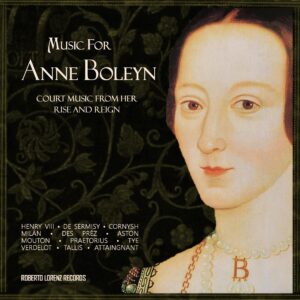 A big thank you to composer and music producer Roberto Lorenz who has written this guest article for us today about his album, “Music for Anne Boleyn – Court music from her rise and reign”, which was released on 7th September 2020.
A big thank you to composer and music producer Roberto Lorenz who has written this guest article for us today about his album, “Music for Anne Boleyn – Court music from her rise and reign”, which was released on 7th September 2020.
Over to Roberto…
Ever since my history teacher first mentioned her, I’ve been obsessed with Anne Boleyn, who, as he put it, “reached the highest peak and fell”. There’s something surreal about Anne’s rapid rise and fall – it’s like a tragic fairy tale and yet a perfect example for the always astonishing, always unpredictable reality of life. Anne Boleyn is one of those historical figures that become more mysterious the more we find out about them. We’ll never fully understand her complex personality, never hear her voice, never see how she moved and gestured, never even know her birthday. However, one direct connection to Anne has survived: the music of her lifetime.
Anne Boleyn lived in an exceptional time for music: the Medieval ages had just transitioned into a new era – the Renaissance – when a richer spectrum of chords and harmonies was developed, new instruments were invented and improved, and the musical notation was elaborated.
My album “Music for Anne Boleyn” includes popular court dances, ballads, and sacred pieces, mostly from Anne’s adult years. The motet “Congregati sunt” (composed by Phillippe Verdelot in 1527) is a striking example for the magic of polyphony, which reached its height in the 16th century. The dance “Tourdion” (first published by Pierre Attaingnant in 1530) was one of the most famous and most referred to evergreens of that time. The anonymous lament “My Lady Carey’s dompe” was probably dedicated to Anne’s sister Mary Boleyn whose husband William Carey died in 1528.
The album also presents four pieces penned by Henry VIII himself. One of the British Library’s treasures is a historical musical collection known as the “Henry VIII songbook”, which includes several songs and instrumental pieces written by “the Kynge H. VIII”. Since Henry was a passionate lute player, it’s tempting to imagine him performing his compositions for Anne during his courting efforts. Who knows for whom he wrote his wistful ballad “If love now reigned” …
The album “Music for Anne Boleyn – Court music from her rise and reign” is available to download and stream in all stores. Here’s a link to the album on Spotify – https://open.spotify.com/album/3YKraczfW4CDMcUz89Ndfy…